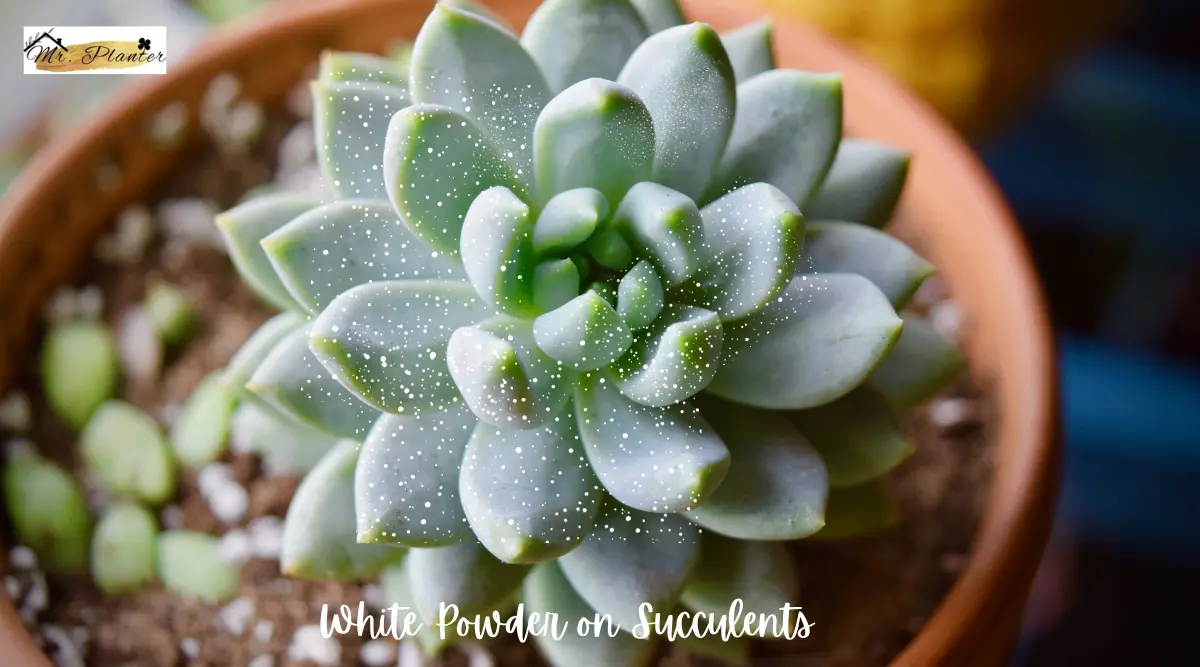If you’re a succulent enthusiast, you may have noticed a white powdery substance on the leaves of your plants. This can be concerning, especially if you’re not sure what it is or how to treat it.
In this article, we’ll explore the causes of white powder on succulents and how to identify and treat it.
White powder on succulents can be caused by a variety of factors, including natural films, mineral buildup, powdery mildew, and mealybugs.
It’s important to understand what’s causing the white powder on your succulents so you can take the appropriate steps to address it. In some cases, the white powder may be harmless, but in others, it can be a sign of a more serious problem.
Identifying the white powder on your succulents can be tricky, as there are several potential causes. It’s important to carefully inspect your plants to determine the source of the white powder.

Once you’ve identified the cause, you can take steps to treat it and prevent it from recurring. In the following sections, we’ll explore the different causes of white powder on succulents and how to address them.
Key Takeaways
- White powder on succulents can be caused by a variety of factors, including natural films, mineral buildup, powdery mildew, and mealybugs.
- It’s important to carefully inspect your plants to determine the source of the white powder.
- Once you’ve identified the cause, you can take steps to treat it and prevent it from recurring.
What Are The White Bits On My Succulents?
If you’ve noticed white bits on your succulents, there are a few possible explanations. Here are some of the most common causes of white powder on succulents:
Powdery Mildew
Powdery mildew is a fungal disease that can affect a wide range of plants, including succulents. It appears as a white, powdery substance on the leaves, stems, and flowers of the plant. This disease is caused by excessive moisture, and it can spread quickly in humid conditions. If left untreated, powdery mildew can damage your succulent and even kill it.
To treat powdery mildew on your succulent, you can use a fungicide spray that is specifically designed for powdery mildew. You can also try removing the affected leaves and increasing the airflow around your succulent to prevent the spread of the disease.
Epicuticular Wax Or Natural Farina
Epicuticular wax is a natural substance that is found on the leaves of many succulent plants. It appears as a powdery, white substance on the leaves and is often mistaken for powdery mildew. This wax helps to protect the plant from moisture loss and can also reflect excess sunlight.
Natural farina is a similar substance that is found on the leaves of some succulent plants, such as Echeveria. It appears as a white, powdery coating on the leaves and is a natural defense mechanism against excess sunlight.
If you notice white powder on your succulent leaves that is evenly distributed and doesn’t rub off easily, it is likely to be farina or epicuticular wax. These substances are harmless and actually help to protect your succulent.
Mealy Bugs
Mealy bugs are small, white insects that can infest your succulent and leave behind a white, powdery residue. They are often found in the crevices between the leaves and stems of the plant. Mealy bugs feed on the sap of the plant and can cause stunted growth and yellowing of the leaves.
To get rid of mealy bugs, you can use a cotton swab dipped in rubbing alcohol to remove them from the plant. You can also use a commercial insecticide spray that is designed to kill mealy bugs.
Mineral Build Up On Succulent Leaves
If you live in an area with hard water, minerals can build up on the leaves of your succulent and leave behind a white, powdery residue. This can also happen if you use tap water to water your succulent.
To prevent mineral buildup on your succulent leaves, you can use distilled water or rainwater to water your plant. You can also wipe the leaves with a damp cloth to remove any mineral buildup.
In conclusion, white powder on succulents can be caused by a variety of factors, including powdery mildew, natural farina or epicuticular wax, mealy bugs, and mineral buildup. By identifying the cause of the white powder on your succulent, you can take the necessary steps to treat and prevent the problem.
How To Identify The White Powder On Succulent?
If you notice a white powder on your succulent’s leaves, it could be a sign of powdery mildew. Powdery mildew is a fungal disease that affects many different types of plants, including succulents. It appears as a powdery white substance on the leaves, stems, and flowers of the plant.
The white powder on your succulent could also be a sign of other issues, such as mineral buildup or epicuticular wax. Mineral buildup occurs when tap water is used on the succulent, causing white spots to appear on the leaves. Meanwhile, epicuticular wax is a natural substance that appears as a thin layer of silvery film on the leaves.
To determine if the white powder on your succulent is powdery mildew, look for signs of fungal infection. Powdery mildew spores can spread quickly, so it’s important to identify and treat it as soon as possible. Here are some signs to look for:
- White or gray powdery spots on the leaves, stems, and flowers
- Leaves that are distorted or curled
- Leaves that are yellowing or browning
- Stunted growth or wilting
If you notice any of these signs, it’s important to take action to treat the powdery mildew.
It’s also important to note that the white powder on your succulent could be a sign of a pest infestation, such as mealybugs or spider mites. These pests can leave behind a powdery substance on the leaves, which can be mistaken for powdery mildew. Look for signs of pests, such as small white or black spots on the leaves, and treat accordingly.
In summary, if you notice a white powder on your succulent’s leaves, it could be a sign of powdery mildew, mineral buildup, epicuticular wax, or a pest infestation. Look for signs of fungal infection or pests, and take action to treat the issue as soon as possible.
Which Part Of The Succulents Generally See White Powder?
If you have noticed a white powder on your succulents, you may be wondering where it is coming from. Generally, the white powder is found on the leaves and stems of the succulent plants.
Succulent Leaves
Succulent leaves are a common place to find white powder. This is because some succulent plants have a naturally occurring waxy buildup on their leaves that helps protect them from sunburn and allows water to run off the leaves more easily. This waxy buildup is called farina or epicuticular wax. Some examples of succulent plants that have this waxy buildup include Echeverias and Kalanchoe lucaie.
However, if the white powder on your succulent leaves is not uniform and is patchy or fuzzy, it may indicate a fungal disease called powdery mildew. Powdery mildew can spread quickly, so it is important to address it as soon as possible to prevent it from spreading to other plants.
Succulent Stems
White powder can also be found on succulent stems. This is often due to a fungal disease called powdery mildew. Powdery mildew can coat the stems and leaves of plants with a white or grayish-white powdery substance.
It is important to note that succulent plants can be sensitive to direct sunlight, especially if they are used to growing in partial shade. If your succulent is getting too much direct sunlight, it may develop a white powdery coating as a natural sunscreen to protect itself from the sun’s rays.
In summary, the white powder on your succulent plants is most commonly found on the leaves and stems. While a uniform waxy buildup on the leaves is normal and healthy, patchy or fuzzy white powder may indicate a fungal disease. Additionally, succulent plants can develop a white powdery coating as a natural sunscreen if they are exposed to too much direct sunlight.
Frequently Asked Questions
What causes white powder on succulents?
White powder on succulents can be caused by a few different things. One common cause is a natural substance called epicuticular wax, also known as farina. This wax can give succulent leaves a powdery appearance, but it is harmless and actually helps to protect the plant from excess sunlight and water loss. However, if the white powder is not uniform across the leaves and appears to be spreading, it may be a sign of powdery mildew or another fungal disease.
What is the difference between farina and powdery mildew?
Farina is a natural substance that appears as a powdery white coating on the leaves of some succulent plants. It is harmless and can actually be beneficial for the plant. Powdery mildew, on the other hand, is a fungal disease that can cause serious damage to succulents if left untreated. Powdery mildew appears as a white or gray powdery coating on the leaves and stems of plants and can spread quickly if not addressed.
How can I get rid of white powder on my succulents?
If the white powder on your succulents is caused by farina, there is no need to do anything as it is harmless. However, if the white powder is caused by powdery mildew or another fungal disease, you will need to take action to protect your plants. One option is to use a fungicide spray that is specifically designed for succulents. You can also try removing affected leaves or stems and isolating the plant to prevent further spread of the disease.
Can white powder on succulents harm other plants?
If the white powder is caused by farina, it is harmless and will not harm other plants. However, if the white powder is caused by powdery mildew or another fungal disease, it can spread to other plants and cause damage. It is important to isolate any affected plants and take steps to prevent the spread of the disease.
Are there any natural remedies for white powder on succulents?
There are a few natural remedies that can be effective in treating powdery mildew and other fungal diseases on succulents. One option is to use a solution of water and neem oil, which has antifungal properties. Another option is to use a solution of water and baking soda, which can help to neutralize the pH of the plant and prevent fungal growth.
What are some common types of fungus that affect succulents?
There are several types of fungus that can affect succulents, including powdery mildew, black spot, and root rot. Powdery mildew is one of the most common fungal diseases and can be identified by the white or gray powdery coating on the leaves and stems of the plant. Black spot is another fungal disease that can cause dark spots on the leaves and stems of the plant. Root rot is a fungal disease that affects the roots of the plant and can cause wilting and yellowing of the leaves.

